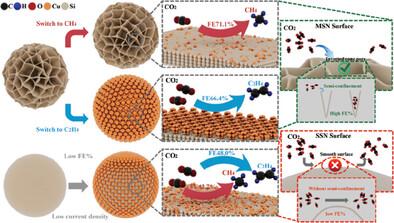半约束效应促进CO2电催化还原过程中CH4和C2H4的生成
IF 13
2区 材料科学
Q1 CHEMISTRY, MULTIDISCIPLINARY
引用次数: 0
摘要
在电化学CO2还原反应(CO2RR)中实现快速转化和精确调控产物选择性一直是一个挑战。空间约束效应为设计不同形态和尺寸的催化剂提供了理论依据,揭示了电子和其他粒子在纳米尺度上的约束所引起的物理现象。本文引入半约束概念,制备了介孔二氧化硅纳米球负载Cu催化剂(Cu- msn),以实现CO2RR增强和产物选择性调节(甲烷对乙烯)。半密闭结构部分解决了经典密闭催化的传质问题。Cu- msn可以通过负载量灵活控制Cu的聚集形态,实现甲烷法拉第效率71.1%到乙烯法拉第效率66.4%的自由切换。各种表征证实了Cu的快速吸附行为和局部配位结构转变(从Cu─O─Si到Cu─O─Cu),可以稳定生成甲烷和乙烯的关键中间体*CHO和*CO*COH。本文章由计算机程序翻译,如有差异,请以英文原文为准。

Semi-Confinement Effect Enhances CH4 and C2H4 Production in CO2 Electrocatalytic Reduction
Achieving fast conversion and precise regulation of product selectivity in electrochemical CO2 reduction reaction (CO2RR) remains a challenge. The space confinement effect provides a theoretical basis for the design of catalysts of different morphology and sizes and reveals the physical phenomena caused by the confinement of electrons and other particles at the nanoscale. In this work, a semi-confinement concept is introduced and a mesoporous silica nanosphere supported Cu catalyst (Cu-MSN) is prepared as a typical example to realize CO2RR enhancement and product selectivity regulation (methane vs ethylene). The semi-confined structure partially solves the mass transfer problem of classical confined catalysis. Cu-MSN allows flexible controls aggregation form of Cu species by loading amount, which achieves a free switch from methane Faraday efficiency of 71.1% to ethylene Faraday efficiency of 66.4%. Various characterizations confirm that the fast adsorption behavior and local coordination structure transformation of Cu (from Cu─O─Si to Cu─O─Cu), which can stabilize key intermediates *CHO and *CO*COH for generating respective methane and ethylene.
求助全文
通过发布文献求助,成功后即可免费获取论文全文。
去求助
来源期刊

Small
工程技术-材料科学:综合
CiteScore
17.70
自引率
3.80%
发文量
1830
审稿时长
2.1 months
期刊介绍:
Small serves as an exceptional platform for both experimental and theoretical studies in fundamental and applied interdisciplinary research at the nano- and microscale. The journal offers a compelling mix of peer-reviewed Research Articles, Reviews, Perspectives, and Comments.
With a remarkable 2022 Journal Impact Factor of 13.3 (Journal Citation Reports from Clarivate Analytics, 2023), Small remains among the top multidisciplinary journals, covering a wide range of topics at the interface of materials science, chemistry, physics, engineering, medicine, and biology.
Small's readership includes biochemists, biologists, biomedical scientists, chemists, engineers, information technologists, materials scientists, physicists, and theoreticians alike.
 求助内容:
求助内容: 应助结果提醒方式:
应助结果提醒方式:


